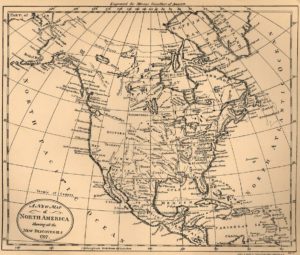 Benjamin E. Park is an assistant professor of history at Sam Houston State University. He studies the cultural, religious, and political history of America between the Revolution and the Civil War. This post originally appeared on his personal blog here.
Benjamin E. Park is an assistant professor of history at Sam Houston State University. He studies the cultural, religious, and political history of America between the Revolution and the Civil War. This post originally appeared on his personal blog here.
Remember when we were all Atlanticists? Apparently we’ve moved on to something new already.
Whereas it used to be “trendy” to place early America’s history in a strictly Atlantic context—in which an emphasis is placed on the intersections between the United States, Europe, and, to a lesser extent, Africa—there has been an upswing in work recently that places the period into conversation with developments taking place in the non-United States nations of North and South America. Three books that came out this year exemplify this trend: Caitlin Fitz’s Our Sister Republics: The United States in an Age of American Revolutions (Liverlight), James Alexander Dun’s Dangerous Neighbors: Making the Haitian Revolution in Early America (University of Pennsylvania Press), and Alan Taylor’s American Revolutions: A Continental History, 1750-1804 (Norton). I hope to highlight each of these books soon—there’s always a hope!—but I wanted to point out a few particular elements of this methodological approach.
Nathan Perl-Rosenthal delivered an excellent paper on what he called the “hemispheric perspective” at AHA this past year, so I’ll mostly be repeating and expanding on what he said at that venue. The entry-point to this new approach, of course, was the Caribbean, which allowed historians to realize there were significant influences on America’s early national development that were geographically much closer to the United States than those bodies across the Atlantic. Especially when considering racial history, the British and French colonial islands played a significant role in mainland development. The Haitian Revolution played a particularly important role, as the slave revolt sparked anti-emancipation fears across the continent. Dun’s new book, then, continues that trend. (I’ve written a bit about how the Age of Revolutions historiography has evolved over at The Junto a few months ago.) I imagine it’s already become a truism that you can’t discuss America’s early republic without given substantial consideration to Toussaint Louverture’s actions–just like it used to be impossible to do the same without considering Robespierre’s.
But the small-yet-significant islands were not the only areas going through revolutionary change during the late-eighteenth and early-nineteenth centuries. As Fitz’s book argues, a number of Latin American nations similarly pushed for their own independence, and Americans were both interested in and engaged with their results. From naming their children after Simón Bolívar to supporting insurrectionists, Fitz uncovered the American fascination with their “sister republics.” The “New World” seemed to be all the rage, even if the “Old World” still played a sizable role. Taylor’s newest exhaustive history of the continental United States follows his old massive textbook—which was similarly praised for its expansive scope and content—in showing how the landscape was an arena for contest between many people and populations. And even while some who are still stuck to old perspectives may demur, this is a needed history that gives context to the persistent presence of diversity in America’s story. I imagine teachers across the nation will be revising their curriculum to incorporate Taylor’s encyclopedic insights, just as they did after the appearance of American Colonies.
So what happens when we invoke a continental/hemispheric approach? First and foremost, it foregrounds the problem of race. Americans encountered both the indigenous bodies who populated the continent as well as the African bodies who had been imported to work the land. Everywhere they looked in their new continent they faced non-white populations. Second, drawing attention away from European connections forces scholars to ask more social and cultural questions and less political and intellectual. Transnational histories have been predominantly centered on the ideological exchanges between white males, but looking at the interchanges between geographic neighbors necessitates another approach. And third, I think this framework extends the chronology of the Age of Revolutions. Rather than a short burst of time that ruptured political and cultural trajectories in new directions toward democracy and freedom, the contest over self-rule worked in fits and starts across various places at different speeds and different results.
I look forward to more work in this field. Partly because it encourages me to retool my American survey lectures, as I know my students need to recognize that our national past took place within a continental context that transcends our traditional Anglo-American narrative. (I wrote a bit about this a couple weeks ago.) But there is still so much more to unpack. For instance, and as our good friends at Borealia will likely point out, we need to do much more to integrate Canada into these stories. And we also need to put all of these revolutionary transformations, continental and Atlantic, into conversation. My good friend Christopher Jones, for example, is working on a manuscript that looks at religion, race, and revolution in Canada, the United States, the Caribbean, as well as West Africa. That’s the type of perspective that will arise out of these historiographical developments.
Perhaps we’re getting to a point where someone can say, tongue-in-cheek, “We are all continentalists now.”

0